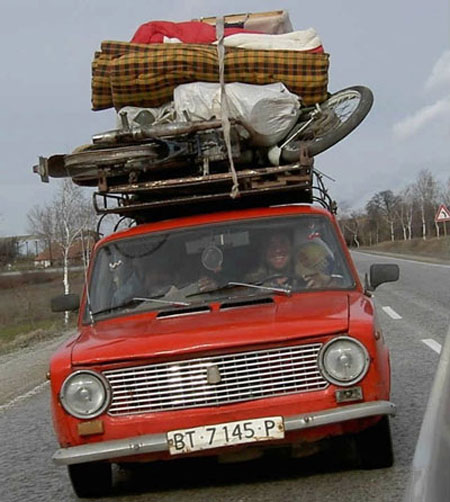Sometimes I feel a bit like this pumpkin — squeezed full of food, overburdened with stuff, maxed out with things to do. (Maybe I’ve had a bit too much Halloween candy, too!). It’s been quite a busy fall – and this week is no exception. I’m packing and moving into a new apartment, it’s Halloween (happy Halloween everyone!) and my birthday was Saturday (Happy twenty-seven to me! How did I get so darn old already? – more on that in another post).
Moving is a great time for reflection, for cleaning out the closet, for looking at what you own, what you need, and what is holding you back or weighing you down. In addition, my birthday – the time of year when I get gifts and my people ask me what I want to celebrate getting older – feels kind of funny this year.
For the past few weeks, I’ve been thinking somewhat aimlessly about things that I might want for my birthday, but each time I draft a new list, I can’t really pick out one thing that I want, or a reason why I should really be buying any MORE stuff. In fact, I’m getting more and more depressed by this exercise of listing all of these things that I want – as though I didn’t have enough stuff already. I was dreaming of a new iphone, some new running shoes, gadgets for my car … the list goes on. But we can always use more stuff – there will be new gadgets, tools, books, bikes, and things to play with and buy. And, each thing that you buy will beget the need for more stuff – in an endless cycle of awesome consumerism. When does it stop?
Moving is compounding the fact that I just have a lot of stuff. I have boxes and boxes of STUFF.
How much stuff does one person need? (Image found here.)
And so, enough. I have enough stuff. I’m putting down the wish lists and the dreams of things that I don’t have – there will always be things that I don’t have. If I were to own all of the possessions in the world, I would end up buried in a pile of stuff.
I have enough stuff. I have more than enough. I have so much stuff, that I ought to give most of it away and look back on the things I own and cherish them.
This birthday, my presents are going to be simple – and while I might benefit from them, I hope that my presents aren’t all about me. Sometimes, birthdays feel kind of selfish. But in the spirit of making birthday lists, this is my wish list this year:
I’d like to (1) find a way to use the stuff I already own, (2) Find ways to celebrate without spending any money, (3) Donate Stuff I don’t need to people and places that can use it, and (4) Support an entrepreneur in a venture to change the world.
Happy Halloween!
Dear Birthday-Santa, I’d only like 4 things, please:
Part 1. Find a way to use the Stuff I already 0wn. One of the blessings of moving – and moving often, as I’ve recently done – is that I can look around at what I own and how much space I take up in the world. In looking at the boxes and boxes of things I have, I’ve decided that my birthday list will include finding useful things to do with the stuff I already own. Sometimes it’s as simple as looking around us and appreciating the things we already own. Here are five things that I love – and I already have them:
- My running shoes. I own running shoes. Running is free. I don’t need to be a member of a club or go to track practice or do anything other than put my shoes on, and run. I can run every day of my life, and I never have to pay anyone to do it. If my running shoes get old, I can run barefoot on the grass. Anyone who tells you that you need “stuff” to go running is wrong. People can hike or walk in sandals, in socks, barefoot on the beach, or with old, crappy shoes. Sure, a nice pair of shoes once a year is a big boost, but the important thing is going for the run – not buying the shoes. And the thing that makes you feel good is going for the run – certainly not the shoes. So, for my birthday, I’m going on a run.
- A bike. Biking isn’t quite free, but it comes close. I feel exceptionally lucky to have an awesome, awesome bike, some rad shoes, and a helmet. I already have it. What I don’t do is actually ride it. My birthday present to myself is going to be a fun ride one weekend morning in November. An even better present is going to be getting up early and going for a long ride before work.
- Yoga. I have a yoga mat. Actually, I have 2 – I really don’t need them both, if anyone wants one. I just learned several new sequences and poses (LOVE them), and I’m going to be practicing these new sequences a lot over the next few weeks. In a word: YAY.
- Swim cap, goggles, and the San Francisco Bay. Now, I actually just lost my last towel. So perhaps I may borrow a beach towel if anyone has any extras to spare. But regardless. Nothing but a mile walk stands between me and Aquatic Park. Time for some cold swims. :)
- An apartment in San Francisco. I’m so excited to be moving back, I can’t stand it. (For those of you who don’t know, I’ve been living temporarily close to work for a while, so it’s exciting to be moving back into an apartment again – especially in one of my favorite cities). I’m glad that I’ll have my own room again. And, while I’m donating a bunch of excess Stuff I don’t need – I’ll also be happy to see some of my Stuff again (kitchen appliances! and my own bookshelves!! and dressers! and a bed that, well, fits me! yay!!!!). That is probably the best birthday present to myself – better than something else new to fill my time.
Beautiful San Francisco – my favorite city (Image from Wikipedia)
Part 2. Celebrate without spending excessive amounts of money. I’d like to ask only for things that don’t cost any money. Time is the most precious resource, and if you would spend your time with me, that is the best gift of all. Sometimes we forget all the great things we can do without money and stuff. Here are some great things to do for a birthday: Go on a bike ride. Make coffee at home and sit in a sunny window. Chat with your friends. Read old magazines. Explore new parks (in San Francisco, there are lots of great parks). Go for a hike. Visit a free museum. Find a new library. Explore the waterfront.
Fleet Week, San Francisco – October 2010
Part 3. Unburden myself of the stuff I don’t need: Donate half of my closet. In a Big Closet Clean-Out, I’m going to be donating half of my clothing and shoes to charity for Thanksgiving and Christmas. Over the next few weeks I’m going to get rid of half of it, using the 2-closet trick. I’m putting all of my clothes into the hall closet. As I use it, I’ll move it into my bedroom closet. What I don’t use, I’ll donate.
Sometimes we get overburdened with stuff, and if you have piles of laundry in front of your closet, with loads of clothes pouring off of your shelves, we should wonder: do we really need all of this stuff? How much stuff should we have in our closets, anyways? What do we really need?
Getting rid of the stuff I don’t need – or that I have too much of – will be nice. Some of the great places that take your clothes are Salvation Army, Good Will, or even consignment shops, if you’re interested in making a small amount of money from your nicer items. (Although see #4 for what to do with that money!)
Is it really necessary to fill all of this space? with Stuff?
Part 4. Fund an Entrepreneur. I think that Entrepreneurs – like Chris Guillebeau (a solo-preneur), Ramit Sethi, Jenny Blake, Leo Babauta, or Jonah Lehrer (these are a few of my favorite bloggers) – are the key to creating new jobs and challenging us to think about truly making ourselves and the world a better place. But throughout the world, many people can’t afford the simple luxuries that we have access to – (and I’m really thankful to be able to live in a beautiful city, have access to the internet and cable television, to have a great education, and so many wonderful friends and family) – and so it’s important to me to help fund equally brilliant people who lack the means to put their ideas into action. KIVA is a great resource for this, and this year, I’ll be donating a small percentage of my salary towards the ambitions of five entrepreneurs.
A great organization – www.kiva.org
I feel such a weight off of my shoulders from this great Fall Clean-Out. This move is especially poignant for me, becuase I feel like I’m finally Sarah again. I’m back in my favorite city in the world (San Francisco!), I’m back doing the things I love doing, and I’m excited to have an apartment to call my own again. What a beautiful present.
I’m happy to say that for my birthday, I’m giving away more things than I’m receiving – finally. Enough with the Stuff. I have more than I could ever possibly need – and I feel so lucky that my life is so blessed in so many ways.
Happy Halloween, everyone!
Image from Leawo
—
Like what you read? Like this on facebook or subscribe to new posts. Got a question or a comment? Leave it in the comments below. This blog is a work in progress and I appreciate any and all feedback.
Also, you can find me on twitter.



























